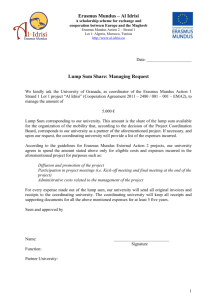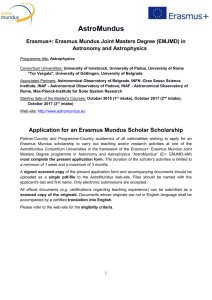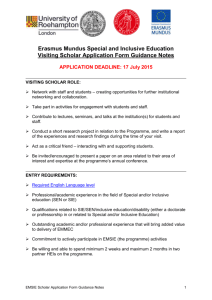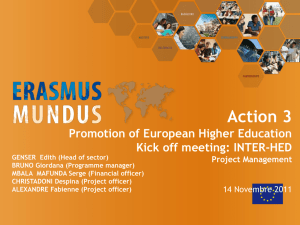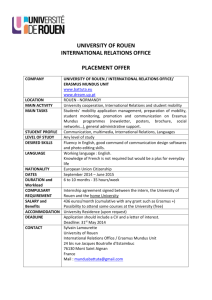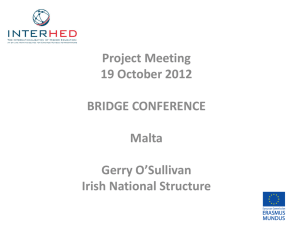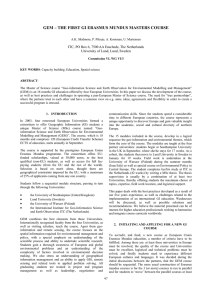Document
advertisement
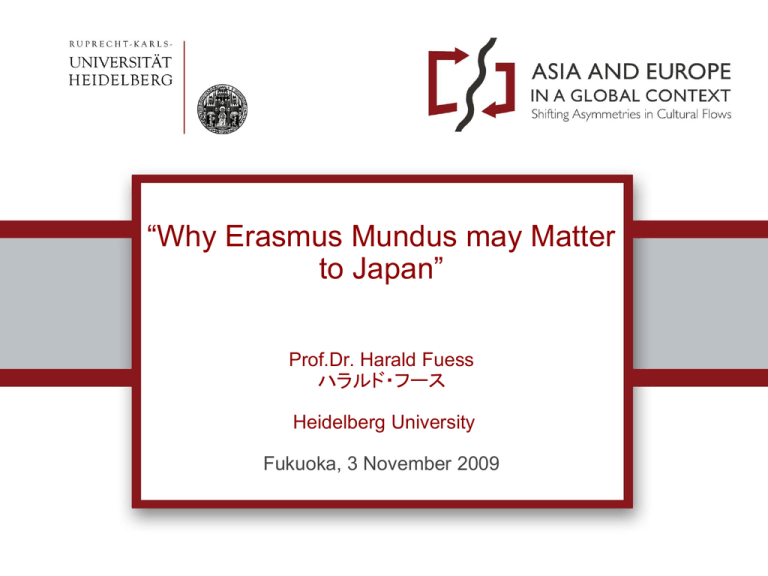
“Why Erasmus Mundus may Matter to Japan” Prof.Dr. Harald Fuess ハラルド・フース Heidelberg University Fukuoka, 3 November 2009 Erasmus Mundus Purpose “Erasmus Mundus (2009-2013) is a cooperation and mobility programme in the field of higher education that aims to enhance the quality of European higher education and to promote dialogue and understanding between people and cultures through cooperation with Third Countries.” Action 1: Joint MA and PhD programs of European and other universities Action 2: European University Cooperation with non-EU universities Action 3: Higher education Promotion Action 1 Purpose and Funding Joint MA programs (joint degrees or double degrees) Supports central coordination Provides scholarships to students and tuition to universities (different rates for EU and non-EU students) Joint PhD programs (joint degrees or double degrees) Supports central coordination Provides high scholarships to students and tuition to universities 2009 Erasmus Mundus MA Selection 50 proposals were selected (29% acceptance rate) 38 programs in the physical and natural sciences; 12 programs in social science and humanities Most lead universities are French (10), Belgian (7), Spanish (6) and Dutch (5) Very few non-European partners (US, Canada, China, India) Only two Japanese universities are currently partners in Erasmus Mundus MA degrees (Tokyo and Osaka) 2009 EM MA Social Science/Humanities Programs 1. Global Studies—European Perspectives 2. Humanitarian Action 3. Economic Development and Growth 4. Tourism management 5. Spanish Multiculturalism and Multiingual Contexts 6. Sport Psychology 7. Knowledge management 8. Migration and Social Cohesion 9. Law and Economics 10. Childhood Education 11. German Literature in the Middle Ages 12. Environmental Sciences, Policy and Management 2009-2010 Student Applicants/Acceptance 1. 22.331 total student applicants for 2009/2010 academic year 2. Most applications from developing countries (Ethiopia 3172, China 1968, India 1877, Pakistan 1764, Bangladesh 1068, Nigeria 919, Ghana 902, Indonesia 678, Iran 615, Nepal 599, Brazil 499) 3. The United States has a very high success rate of 73 out of 297 applicants and 33 Canadians were accepted out of 128 ONLY TWO JAPANESE STUDENTS ACCEPTED out of 16 Japanese who applied 2009 Erasmus Mundus PhD Selection 13 programs Selected (10% acceptance rate) 10 programs are in the sciences. Three others are: (1) “Globalization, Europe and Multilateralism” and (2) “Forest and Nature for Society” (3) “Cultural Studies in Literary Interzones” Lead University are French (4) or Italian (4) with a total of 11 French partner universities Several successful joint PhD programs also have an EMMA Only two programmes have East Asian partners. Waseda is the only Japanese partner University Action 2 and 3 Purpose and Funding Action 2: European University Cooperation with non-EU universities North Africa Latin America, Russia, Georgia, Armenia etc. Middle East China, India Not a single Japanese university is part of the program Action 3: Higher education Promotion Only for EU organizations that promote the mobility of scholars CONCLUSION Erasmus Mundus encourages the “Bolonga Process“ of European University Integration with EU Funding Increases the International Visibility of selected Education Programs to Students and provides reputational spin-offs and advertisement Mostly supportive of physical and natural sciences programs Still few non-European partner universities EU selection process is time-consuming, bureaucratic, and non-transparent Erasmus Mundus degrees may be cumbersome to run Thank you! Further information at http://eacea.ec.europa.eu/erasm us_mundus/index_en.php Back-up
